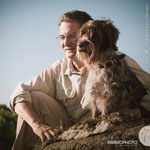Kennel training
There are three essential things about the kennel:
1. The dog must enter with pleasure.
2. He must remain calm.
3. He must wait for a command before leaving it.It is important that the dog stays calmly in his kennel when the door opens. For example, when I open the kennel door, I do not want to have to catch my hunting dog trying to escape to run in the woods or get hit by a car.
I train my dogs in a positive way to get in the kennel and stay calm. The method proposed here uses only the reward.
These tree learnings are easy to teach and can be done at the same time.
It is not necessary to speak except to release the dog from his kennel.
We need some elements:
- Very desirable and easy to swallow food.
- A hungry dog.
- A kennel whose door has been removed or attached so that the dog can enter and exit without danger or obstruction.
- The door must be easy to open and close (no canvas kennel).
- If using a wire kennel: protect the top of the door frame with foam rubber, protect the bottom of the door frame with a few layers of "duct tape" to prevent the dog from getting injured.
First, make sure the kennel is a nice and safe place for the dog. The kennel must not be a place used for punishment. When we proceed correctly, our dog will love his kennel and we will often be surprised to find that our dog gets in the kennel voluntarily to rest.
Method
- Stand near the kennel while our dog sees us.
- Delicately pitch a reward in the kennel so that the dog can see the food that falls in it.
- Use a gesture that will eventually become a gestural command, such as a movement of the index that points inside the kennel.
- Enter your hand through the door.
- Feed the dog in the middle of the ceiling.
- Take out your hand.
- Close the door.
- Lock the door.
- Release the door.
- Stand up.
- Do not open the door if the dog is barking, whining, scratching, is excited, etc.
- The dog should not do anything other than sitting calm.
- Release the dog from the kennel using a verbal or gestural command of your choice.
- If the dog moves his head through the door (even if he does not move his feet), close the door.
- When the dog anticipates and enters the kennel voluntarily when we begin to do our command, do not pitch the reward but give it to him in the kennel.
- When the gesture-command is well understood by the dog, it can be associated with a verbal command, eg "Kennel" followed by the gesture command - and when the dog enters the kennel, he is given his reward.
- Increase the level of difficulty, for example:
- Open the door, wait a little before feeding.
- Go a bit farther away before feeding.
- Add distractions (ex: leave in the hands, then attach it to the collar, note, this is very difficult for some dogs
- Practice in various situations.
- Try to succeed every time.
- Do not make 2 mistakes in a row. Return to a level where the dog succeeds.
- The dog makes his choices. Do not try to help the dog. Do not prevent it from making mistakes.
Also see my article (in French): Cage pour chien: outil essentiel ou instrument cruel?
Louis Cimon
Mai 2019
